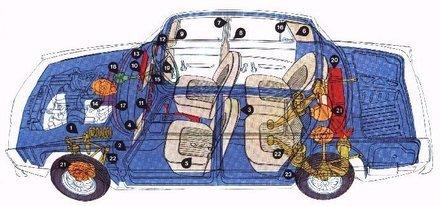P6 safety


Base Unit
1. The base unit method of construction makes it possible to locate the passenger compartment within a robust steel cage designed to resist distortion and protext the occupants.
2. The steel bulkhead, moreover, is designed to prevent the engine penetrating to the passenger compartment in event of a head-on collision.
Interior Furnishing
3. The front seats have a padded roll along the top edge of the back to lessen the likelihood of head injuries to rear seat passengers thrown forward in a collision. In the event of rear impact the squab will also 'give' rearwards thus minimising risk of neck injuries.
4. The glove lockers positionedat knee height have a flat padded surfaced backed by a material which will collapse in the event of impact, therefore affording protection to the knees.
5. The seats are designed on the basis of medical advice to support the small of the back and have infinite rake adjustment.
6.Vital areas of the roof and rear quarter panels are fitted with thick resilient padding.
7. Provision for inertia reel safety harness on front seats.
8. The rear door lock interior handle cannot be operated when the sill-bottun is depressed to minimise accidental opening of the door by a child. The door can still be opened from inside in an emergency. Anti-burst locks are fitted to all four doors.
9. The sun visors are softley padded and collapse in impact.
Controls
10. Instrruments mounted close to normal line of vision to reduce visual adjustment when driver refocuses from road to instrument. (Many people have difficulty refocusing rapidly).
11. Switches are designed and marked to minimise injury and give easy recognition.
12. Interior mirror fitted with protective frame.
13. 'BRAKE' shows on instrument panel when brake fluid reservoir is low or handbrake is on.
Ventilating System
14. To minimise fatigue and drowsiness, the car is fitted with a through-flow ventilation system.
15. Fresh air ducts at face level can be operated individually regardless of heater setting.
16. Opening rear quarter vents for additional ventilation.
17. Air intake is above the exhaust level of other vehicles.
Steering
18. Steering box mounted high up on the scuttle at the rear of the engine to avoid the steering column and the wheel being pushed up to the passenger area in a head-on collision.
19. The steering wheel is dished for safety and adjustable for the most comfortable position.
Fuel System
20. The fuel tank is positioned within the main structure of the car and separated from the passengers by a steel bulkhead.
Braking System
21. Servo-assisted disc brakes on all four wheels for the maximum stopping power.
Suspension
22. Independent suspension of the front wheels and De dion suspension at the rear gives the car great stability and cornering power, with safety.
Tyres
23. Radial ply tyres not only fitted as standard but included as part of the basic design. They provide improved handling, precision steering response and offer better adhesion on wet surfaces
...that coffee is the seed of a cherry from the tree genus Coffea, a tree yielding about 1kg (2lb) of coffee per year. There are more than 25 species of coffee, the 3 main commercial types being Robusta, Liberia and Arabica, the latter representing 70% of total production.
In March 2008 the heavily indebted Ford Company sold their British prestigious carmakers Jaguar and Land Rover along with the Rover Brand, the Daimler brand and the Lanchester brand.
Read more